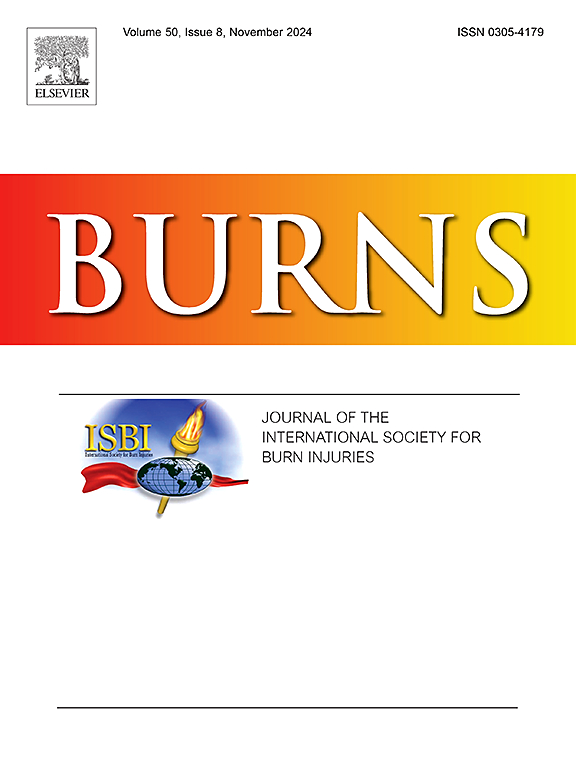Ethnicity does not change burn resuscitation and time to first excision
IF 3.2
3区 医学
Q2 CRITICAL CARE MEDICINE
引用次数: 0
Abstract
Health and racial disparities can limit access to preventative, trauma, and chronic disease care but have not been addressed in burn resuscitation. Over- and under-resuscitation contribute to increased overall hospital costs, and morbidity and mortality rates. The primary objective of this study was to identify potential racial disparities that may exist during the initial fluid resuscitation after burn injury. This was a retrospective review of all burn patients > 14 years of age admitted between January 1, 2020 and December 31, 2022 to a county safety net hospital. Patients were excluded if they transitioned to comfort care within 24 hours of admission. Data collected included baseline demographics, relevant burn injury information, and laboratory parameters. Outcomes included hospital and ICU length of stay, duration of mechanical ventilation, payor status, and mortality. Patients were divided into white (59 %) vs. African American-Hispanic (AA-HIS) (41 %) and included 105 patients. The median age (IQR) was 44.5(30) for whites vs 34(36) for AA-HIS. There were no statistically significant differences in severity of burn injury, cause of burn injury, rates of inhalation injury, or ICU or hospital lengths of stay. In both groups 55 % of the patients required mechanical ventilation while 18 % required renal replacement therapy. Overall mortality was not higher in the AA-HIS group at 32.6 % vs 17.7 % (p = 0.081). There were no differences in amount of fluid administered, urine output, laboratory values during resuscitation, or patient outcomes between the groups. The use of protocols for burn resuscitation can be instrumental in protecting against racial and ethnic disparities.
种族不影响烧伤复苏和第一次切除的时间。
健康和种族差异可能限制获得预防性、创伤性和慢性疾病护理,但在烧伤复苏中尚未得到解决。复苏过度和复苏不足导致医院总费用、发病率和死亡率增加。本研究的主要目的是确定在烧伤后初始液体复苏期间可能存在的潜在种族差异。这是一项对2020年1月1日至2022年12月31日期间在县安全网医院住院的所有14岁烧伤患者bb0 的回顾性研究。如果患者在入院后24 小时内过渡到舒适护理,则排除。收集的数据包括基线人口统计数据、相关烧伤信息和实验室参数。结果包括住院和ICU住院时间、机械通气持续时间、付款人状况和死亡率。患者分为白人(59 %)和非洲裔美国-西班牙裔(41 %),共纳入105例患者。白人的中位年龄(IQR)为44.5(30),AA-HIS的中位年龄为34(36)。两组在烧伤严重程度、烧伤原因、吸入性损伤发生率、ICU或住院时间方面无统计学差异。两组患者中55% %需要机械通气,18% %需要肾脏替代治疗。AA-HIS组的总死亡率不高,分别为32.6% %和17.7 % (p = 0.081)。两组患者在给液量、尿量、复苏期间的实验室值或患者预后方面均无差异。使用烧伤复苏方案可以有助于防止种族和民族差异。
本文章由计算机程序翻译,如有差异,请以英文原文为准。
求助全文
约1分钟内获得全文
求助全文
来源期刊

Burns
医学-皮肤病学
CiteScore
4.50
自引率
18.50%
发文量
304
审稿时长
72 days
期刊介绍:
Burns aims to foster the exchange of information among all engaged in preventing and treating the effects of burns. The journal focuses on clinical, scientific and social aspects of these injuries and covers the prevention of the injury, the epidemiology of such injuries and all aspects of treatment including development of new techniques and technologies and verification of existing ones. Regular features include clinical and scientific papers, state of the art reviews and descriptions of burn-care in practice.
Topics covered by Burns include: the effects of smoke on man and animals, their tissues and cells; the responses to and treatment of patients and animals with chemical injuries to the skin; the biological and clinical effects of cold injuries; surgical techniques which are, or may be relevant to the treatment of burned patients during the acute or reconstructive phase following injury; well controlled laboratory studies of the effectiveness of anti-microbial agents on infection and new materials on scarring and healing; inflammatory responses to injury, effectiveness of related agents and other compounds used to modify the physiological and cellular responses to the injury; experimental studies of burns and the outcome of burn wound healing; regenerative medicine concerning the skin.
 求助内容:
求助内容: 应助结果提醒方式:
应助结果提醒方式:


